Friday, October 08, 2021
When analog fertilized digital
IBM started with the purely digital and mostly mechanical Hollerith sorter. The sorter remained mostly mechanical for many decades. In the '30s the company expanded into generalized Business Machines, everything from intercoms to timeclocks. As part of their expansion they took a chance on a mostly analog invention, and the resulting hybrid grew and flourished.
In 1932, high school physics teacher Reynold Johnson got tired of grading tests. He took advantage of his unique knowledge and talents to build a test-grading machine.
His original prototype was crude, just a proof of concept, and wouldn't have helped in grading. His second idea caught the attention of an important statistician, who brought it to IBM.
Top view:
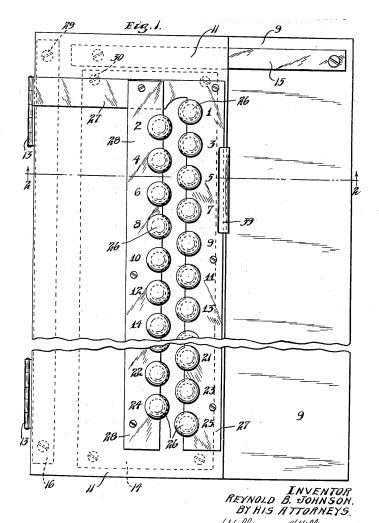 Side view:
Side view:
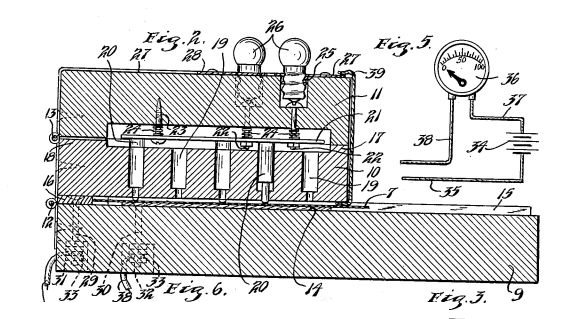 His prototype used the same principle as the Hollerith punch. Remove material to create a conductive spot. The test paper would be conductive, and coated with a set of pasted-on non-conductive squares. The student would peel off a square for each desired answer, and a matrix of pins would make contact with the conductive paper. A key sheet with the correct answers would occupy a second pin-press, and lights would indicate where the student paper's conductivity disagreed with the key sheet's conductivity. The paper would be expensive to make, and the process would be too delicate for most students.
This first concept was purely digital, with a glowing lamp for each peeled square that disagreed with the peeled square on the key sheet. The teacher would be able to see which of the peeled spots disagreed with the key sheet, which she could have seen easily enough without the whole mechanism!
Johnson's second concept, like many Big Ideas, inverted the original. Instead of removing an insulator to create a conductive point, add a conductive point to create a conductive point. Replace punches with pencils. Wireless experimenters were familiar with the semiconductor properties of graphite. Johnson placed a pair of contacts close together on each standardized square of ordinary paper. If there was a smear of graphite in this narrow rectangle, there would be a current between the contacts.
Now the analog and balancy part takes over. Instead of lighting a single light for each disagreeing contact, the machine would sense the graphite conduction of each individual answer, and compare it against the correct answers on a key sheet. This comparison or subtraction would provide a delta of current in one direction.
His prototype used the same principle as the Hollerith punch. Remove material to create a conductive spot. The test paper would be conductive, and coated with a set of pasted-on non-conductive squares. The student would peel off a square for each desired answer, and a matrix of pins would make contact with the conductive paper. A key sheet with the correct answers would occupy a second pin-press, and lights would indicate where the student paper's conductivity disagreed with the key sheet's conductivity. The paper would be expensive to make, and the process would be too delicate for most students.
This first concept was purely digital, with a glowing lamp for each peeled square that disagreed with the peeled square on the key sheet. The teacher would be able to see which of the peeled spots disagreed with the key sheet, which she could have seen easily enough without the whole mechanism!
Johnson's second concept, like many Big Ideas, inverted the original. Instead of removing an insulator to create a conductive point, add a conductive point to create a conductive point. Replace punches with pencils. Wireless experimenters were familiar with the semiconductor properties of graphite. Johnson placed a pair of contacts close together on each standardized square of ordinary paper. If there was a smear of graphite in this narrow rectangle, there would be a current between the contacts.
Now the analog and balancy part takes over. Instead of lighting a single light for each disagreeing contact, the machine would sense the graphite conduction of each individual answer, and compare it against the correct answers on a key sheet. This comparison or subtraction would provide a delta of current in one direction.
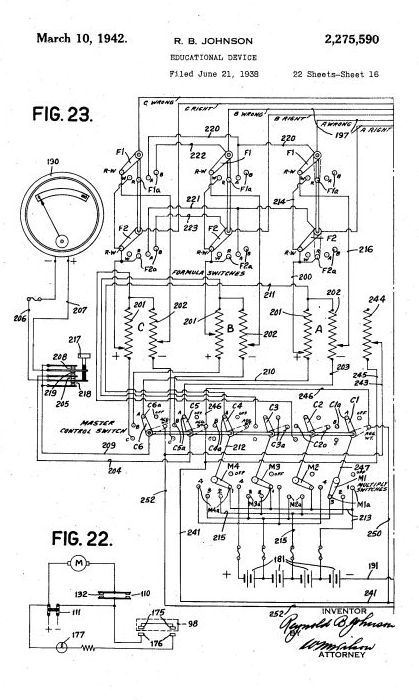 The total of the deltas would then be summed up in an analog way and indicated on a meter.
= = = = =
After IBM hired Johnson, he was able to work with their vast array of electronic and mechanical resources. Their workshop turned the concept into a first machine, somewhat rough-looking but fully usable.
The total of the deltas would then be summed up in an analog way and indicated on a meter.
= = = = =
After IBM hired Johnson, he was able to work with their vast array of electronic and mechanical resources. Their workshop turned the concept into a first machine, somewhat rough-looking but fully usable.
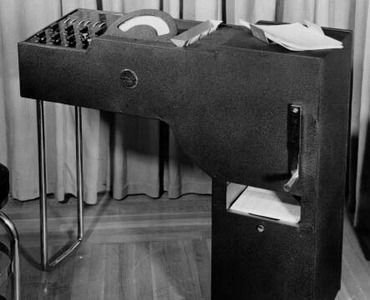 The correct key sheet was kept inside the upper right box. Each student paper was inserted in the middle hopper, then the teacher would turn the crank to run the paper into the comparison press, where the rights and wrongs balanced into the meter reading. The paper then flowed down onto the stack.
The knobs on the left were complicated and I suspect they were rarely used. It was possible to section off the key sheet into groups with different weightings. Each knob set the weights for the sections, and the master knob normalized the result to 100 with a calibration sheet.
A later and more convenient version, the 805, motorized and automated the paper action.
Here teacher Polistra is assisted by TA Happystar. The answer key (red here) stays in the front hopper. Happystar inserts one student sheet into the back hopper. Polistra notes the name of the student and pushes the button to process the sheet. The total correct shows on the meter, and she writes the total in her gradebook. (The gradebook would be on the 'wing' of the grading machine.)
The correct key sheet was kept inside the upper right box. Each student paper was inserted in the middle hopper, then the teacher would turn the crank to run the paper into the comparison press, where the rights and wrongs balanced into the meter reading. The paper then flowed down onto the stack.
The knobs on the left were complicated and I suspect they were rarely used. It was possible to section off the key sheet into groups with different weightings. Each knob set the weights for the sections, and the master knob normalized the result to 100 with a calibration sheet.
A later and more convenient version, the 805, motorized and automated the paper action.
Here teacher Polistra is assisted by TA Happystar. The answer key (red here) stays in the front hopper. Happystar inserts one student sheet into the back hopper. Polistra notes the name of the student and pushes the button to process the sheet. The total correct shows on the meter, and she writes the total in her gradebook. (The gradebook would be on the 'wing' of the grading machine.)
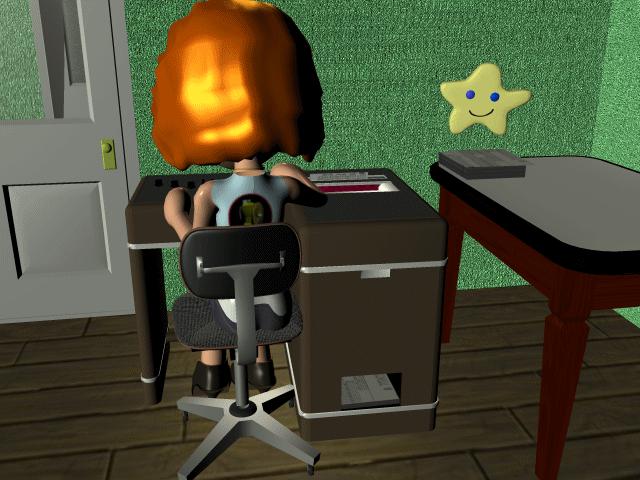 Top view to show the multiplier knobs and meter action:
Top view to show the multiplier knobs and meter action:
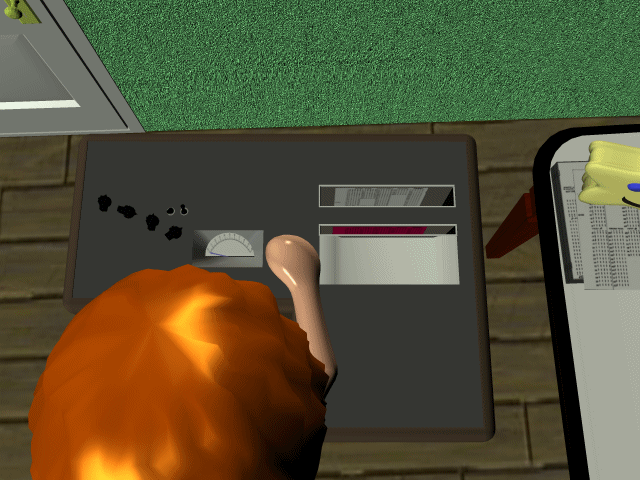 = = = = =
There are only a few pictures of the 805 online. None of the usual computer museums or collectors own one, so there are no new pix or videos. The old pictures disagree on the combination of knobs and the mode of operation. Some seem to show the teacher writing grades on the student answer sheet after running it through the comparison. The sheet appears to be on a roller, and a later patent shows rollers. This action is entirely unclear, so I've stuck with the fairly clear action seen in the earlier patent. Insert, measure, write grade in gradebook, drop into stack at bottom.
= = = = =
Reynold Johnson stayed at IBM. His team developed a huge variety of inventions, focused on analog transducers serving as sensors for digital machines. The 805 graphite grader evolved into the 1230 optical grader, providing detailed digital counts and records. His biggest breakthrough was the 350 hard disk drive in 1957, which I'll feature in the next item.
= = = = =
There are only a few pictures of the 805 online. None of the usual computer museums or collectors own one, so there are no new pix or videos. The old pictures disagree on the combination of knobs and the mode of operation. Some seem to show the teacher writing grades on the student answer sheet after running it through the comparison. The sheet appears to be on a roller, and a later patent shows rollers. This action is entirely unclear, so I've stuck with the fairly clear action seen in the earlier patent. Insert, measure, write grade in gradebook, drop into stack at bottom.
= = = = =
Reynold Johnson stayed at IBM. His team developed a huge variety of inventions, focused on analog transducers serving as sensors for digital machines. The 805 graphite grader evolved into the 1230 optical grader, providing detailed digital counts and records. His biggest breakthrough was the 350 hard disk drive in 1957, which I'll feature in the next item.
 Side view:
Side view:
 His prototype used the same principle as the Hollerith punch. Remove material to create a conductive spot. The test paper would be conductive, and coated with a set of pasted-on non-conductive squares. The student would peel off a square for each desired answer, and a matrix of pins would make contact with the conductive paper. A key sheet with the correct answers would occupy a second pin-press, and lights would indicate where the student paper's conductivity disagreed with the key sheet's conductivity. The paper would be expensive to make, and the process would be too delicate for most students.
This first concept was purely digital, with a glowing lamp for each peeled square that disagreed with the peeled square on the key sheet. The teacher would be able to see which of the peeled spots disagreed with the key sheet, which she could have seen easily enough without the whole mechanism!
Johnson's second concept, like many Big Ideas, inverted the original. Instead of removing an insulator to create a conductive point, add a conductive point to create a conductive point. Replace punches with pencils. Wireless experimenters were familiar with the semiconductor properties of graphite. Johnson placed a pair of contacts close together on each standardized square of ordinary paper. If there was a smear of graphite in this narrow rectangle, there would be a current between the contacts.
Now the analog and balancy part takes over. Instead of lighting a single light for each disagreeing contact, the machine would sense the graphite conduction of each individual answer, and compare it against the correct answers on a key sheet. This comparison or subtraction would provide a delta of current in one direction.
His prototype used the same principle as the Hollerith punch. Remove material to create a conductive spot. The test paper would be conductive, and coated with a set of pasted-on non-conductive squares. The student would peel off a square for each desired answer, and a matrix of pins would make contact with the conductive paper. A key sheet with the correct answers would occupy a second pin-press, and lights would indicate where the student paper's conductivity disagreed with the key sheet's conductivity. The paper would be expensive to make, and the process would be too delicate for most students.
This first concept was purely digital, with a glowing lamp for each peeled square that disagreed with the peeled square on the key sheet. The teacher would be able to see which of the peeled spots disagreed with the key sheet, which she could have seen easily enough without the whole mechanism!
Johnson's second concept, like many Big Ideas, inverted the original. Instead of removing an insulator to create a conductive point, add a conductive point to create a conductive point. Replace punches with pencils. Wireless experimenters were familiar with the semiconductor properties of graphite. Johnson placed a pair of contacts close together on each standardized square of ordinary paper. If there was a smear of graphite in this narrow rectangle, there would be a current between the contacts.
Now the analog and balancy part takes over. Instead of lighting a single light for each disagreeing contact, the machine would sense the graphite conduction of each individual answer, and compare it against the correct answers on a key sheet. This comparison or subtraction would provide a delta of current in one direction.
 The total of the deltas would then be summed up in an analog way and indicated on a meter.
= = = = =
After IBM hired Johnson, he was able to work with their vast array of electronic and mechanical resources. Their workshop turned the concept into a first machine, somewhat rough-looking but fully usable.
The total of the deltas would then be summed up in an analog way and indicated on a meter.
= = = = =
After IBM hired Johnson, he was able to work with their vast array of electronic and mechanical resources. Their workshop turned the concept into a first machine, somewhat rough-looking but fully usable.
 The correct key sheet was kept inside the upper right box. Each student paper was inserted in the middle hopper, then the teacher would turn the crank to run the paper into the comparison press, where the rights and wrongs balanced into the meter reading. The paper then flowed down onto the stack.
The knobs on the left were complicated and I suspect they were rarely used. It was possible to section off the key sheet into groups with different weightings. Each knob set the weights for the sections, and the master knob normalized the result to 100 with a calibration sheet.
A later and more convenient version, the 805, motorized and automated the paper action.
Here teacher Polistra is assisted by TA Happystar. The answer key (red here) stays in the front hopper. Happystar inserts one student sheet into the back hopper. Polistra notes the name of the student and pushes the button to process the sheet. The total correct shows on the meter, and she writes the total in her gradebook. (The gradebook would be on the 'wing' of the grading machine.)
The correct key sheet was kept inside the upper right box. Each student paper was inserted in the middle hopper, then the teacher would turn the crank to run the paper into the comparison press, where the rights and wrongs balanced into the meter reading. The paper then flowed down onto the stack.
The knobs on the left were complicated and I suspect they were rarely used. It was possible to section off the key sheet into groups with different weightings. Each knob set the weights for the sections, and the master knob normalized the result to 100 with a calibration sheet.
A later and more convenient version, the 805, motorized and automated the paper action.
Here teacher Polistra is assisted by TA Happystar. The answer key (red here) stays in the front hopper. Happystar inserts one student sheet into the back hopper. Polistra notes the name of the student and pushes the button to process the sheet. The total correct shows on the meter, and she writes the total in her gradebook. (The gradebook would be on the 'wing' of the grading machine.)
 Top view to show the multiplier knobs and meter action:
Top view to show the multiplier knobs and meter action:
 = = = = =
There are only a few pictures of the 805 online. None of the usual computer museums or collectors own one, so there are no new pix or videos. The old pictures disagree on the combination of knobs and the mode of operation. Some seem to show the teacher writing grades on the student answer sheet after running it through the comparison. The sheet appears to be on a roller, and a later patent shows rollers. This action is entirely unclear, so I've stuck with the fairly clear action seen in the earlier patent. Insert, measure, write grade in gradebook, drop into stack at bottom.
= = = = =
Reynold Johnson stayed at IBM. His team developed a huge variety of inventions, focused on analog transducers serving as sensors for digital machines. The 805 graphite grader evolved into the 1230 optical grader, providing detailed digital counts and records. His biggest breakthrough was the 350 hard disk drive in 1957, which I'll feature in the next item.
= = = = =
There are only a few pictures of the 805 online. None of the usual computer museums or collectors own one, so there are no new pix or videos. The old pictures disagree on the combination of knobs and the mode of operation. Some seem to show the teacher writing grades on the student answer sheet after running it through the comparison. The sheet appears to be on a roller, and a later patent shows rollers. This action is entirely unclear, so I've stuck with the fairly clear action seen in the earlier patent. Insert, measure, write grade in gradebook, drop into stack at bottom.
= = = = =
Reynold Johnson stayed at IBM. His team developed a huge variety of inventions, focused on analog transducers serving as sensors for digital machines. The 805 graphite grader evolved into the 1230 optical grader, providing detailed digital counts and records. His biggest breakthrough was the 350 hard disk drive in 1957, which I'll feature in the next item.
Labels: Equipoise
